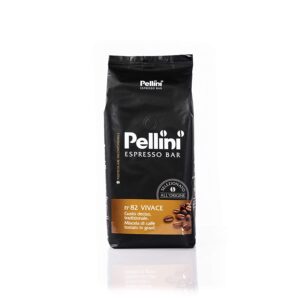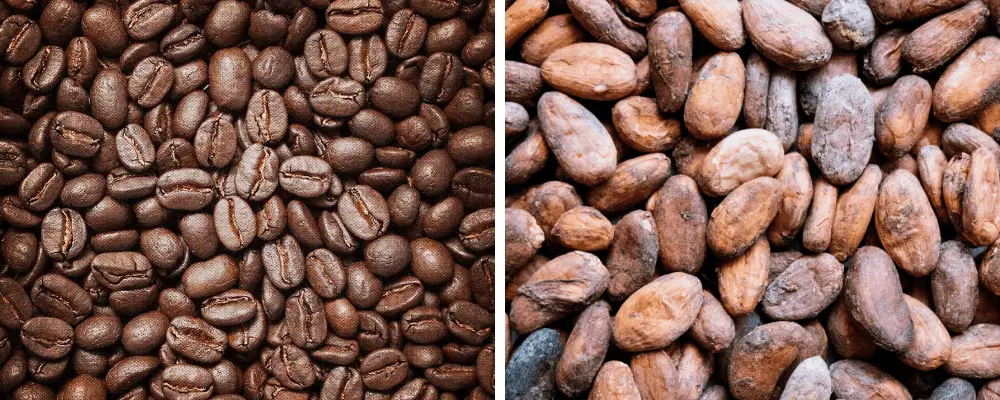
In case you’re wondering if coffee and chocolate are made from the same bean, here are a few things you should know.
Coffee and chocolate are made from different beans. Coffee beans grow naturally, while chocolate is a product manufactured from cacao beans. Although both coffee and cacao trees grow in regions native to the equator, they produce beans with a different appearance, flavor, and smell.
People often wonder if coffee and chocolate come from the same beans, so I put together this simple guide to explain what makes each unique.
Let’s cover some basics like:
- What do coffee and cacao beans and trees look like?
- How does the taste of a coffee bean compare to chocolate?
- Are coffee and chocolate related?
By the end of this article, you’ll be an expert on the similarities and differences between coffee and chocolate.
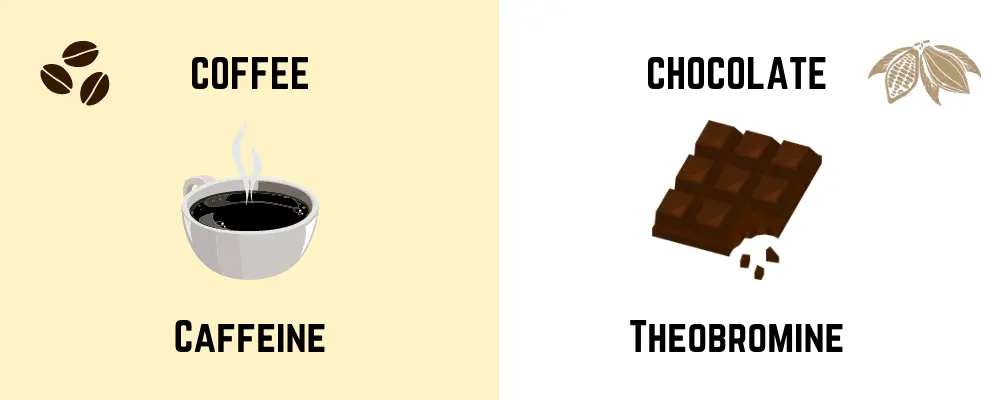
Coffee and Cacao Beans
Let’s take a closer look at coffee and cacao beans, what they look like, and where they come from.
To keep things simple, let’s start with the difference between coffee and cacao trees and see how the beans are made.
Even though the trees grow in similar regions and climates, they are completely unique. Cacao trees, often called trees of the gods, are much taller. Their formal name is Theobroma cacao. Coffee trees tend to be shorter but produce a lot more fruit.
Here is a side-by-side look at a coffee tree and a cacao tree.
Coffee Tree
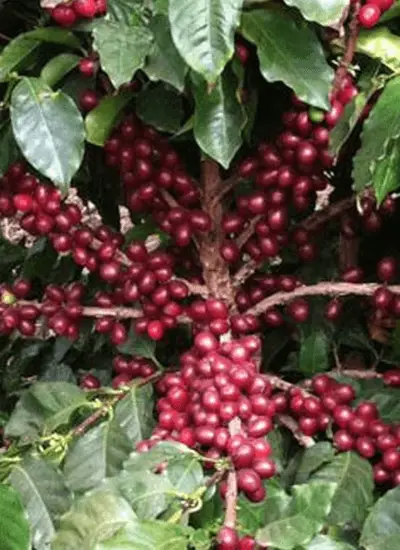
- Native to tropical regions around the equator.
- Size: 6-15 feet.
- Produces an average of 4,000 coffee beans per year.
Cacao Tree
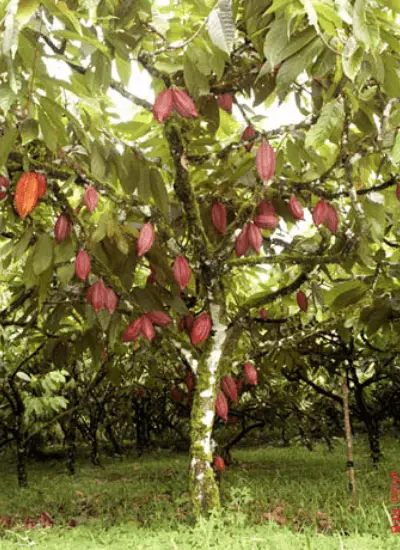
- Native to Latin America, West Africa, and Southeast Asia
- Size: 15-25 feet.
- Each tree will yield 20 to 30 pods per year.
Both trees produce their own fruits. Coffee trees grow cherries, and cacao trees grow cacao pods. The beans, or seeds, are inside these fruits.
Coffee Fruit
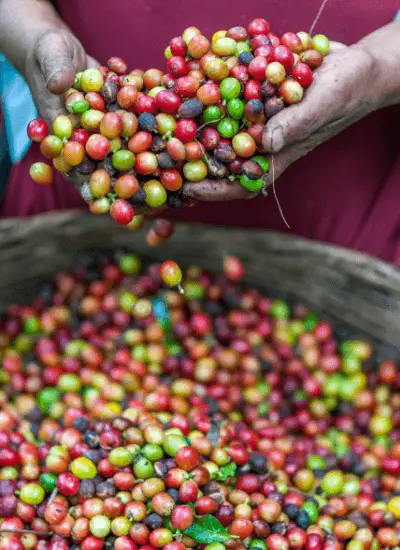
- Coffee fruit is known as the cherry.
- Each cherry has 2 coffee beans inside.
- Coffee beans pulled from coffee cherries are pale and often white. It’s the roasting process that gives coffee beans their brown color.
Cacao Fruit

- Cacao fruit is known as a cacao pod.
- Each cacao pod contains 20 to 50 beans.
- Cacao beans are dried, fermented, ground, and processed into chocolate.
It’s the drying and roasting process that gives cacao and coffee the color and smell that we’re used to. Each company has a unique way of roasting and manufacturing these beans.
Roasted Coffee Bean

Roasted Cacao Bean
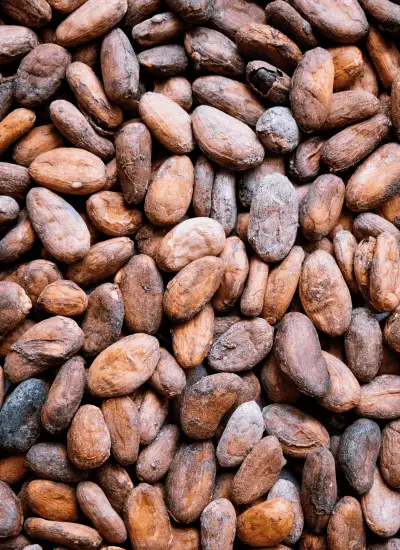
The coffee beans are ready to be mixed with hot water to make the world’s most famous drink. Once roasted cacao is often referred to as coco.
Cocoa beans will be ground and mixed with other ingredients before they become chocolate.
How Do Coffee Beans and Cacao Beans Taste?
Raw coffee beans and cocoa beans are earthy and bitter. You’ll never catch anyone sacking on them as if they were peanuts.
It’s the roasting process that brings out the famous flavors from these beans. Let’s start with cacao.
There are four common types of cacao plants: forastero, criollo, trinitario, and nacional. Each produces a fruit slightly different than the other in shape and color.
Roasted cacao bean flavor can be described as something similar to dark chocolate. They are crunchy, biter, and nutty. A person who loves chocolate wouldn’t find the taste of cacao beans very satisfying or familiar.
The beans are crushed, mixed with sweeteners, and formed into chocolate bars and other chocolate confections.
Since coffee beans are a final product, they have a wider variety of flavors which really depend on the producer.
Coffee suppliers pride themselves on the flavor of their coffee beans. Unique tastes are a result of roasting techniques as well as where the bean was grown.
This image shows the life cycle of a coffee bean, from its beginning as a flower to its final form as a roasted coffee bean.

The most common coffee bean come from Central and South America and Africa.
This may sound like an oversimplification but, African coffee beans have citrusy, floral, and fruity notes, whereas their South American counterparts tend to have nutty, chocolatey, and caramel tones.
There’s more to know about the difference between African and South American coffee beans, and you can find all the information here.
It’s important to remember there is more than one type of coffee bean. The two most common types are Arabica and Robusta, but more are still more being discovered in Ethiopia to this day.
Are Coffee and Chocolate Related?
As you should be able to tell by now, they are not related. Coffee and chocolate come from different trees, fruits, and beans. They even originated on different continents.
Coffee originated from Africa. Ethiopia and Yemen specifically. Today it’s grown in regions close to the equator around the whole planet.
Cacao beans come from South America and are a much newer discovery.
Most of the world’s cacao is currently gown in Africa, while South America has taken over the coffee business. Brazil and Colombia are known for making the best coffee. Ghana and Ivory Coast are world leaders in cacao exports.
So, coffee and chocolate, or cacao, are two very different things. Even though they grow in similar regions and share colors they look, taste, and smell completely differently. What’s more important is their effect on your body.
Coffee has caffeine which boosts your energy. Perhaps that’s why it’s the most famous drink on the planet.
Chocolate is a dessert. Originally created for royal families but made available to common folks shorty after. Cacao also contains caffeine but not enough to be a stimulant.
What Do Coffee and Chocolate Have in Common?
One of the main similarities between coffee and chocolate is that they both stimulate our minds. Caffeine in coffee and theobromine in chocolate focus our brains and attention.
I don’t recommend switching your morning cup of coffee for a chocolate bar. The compound in chocolate is a lot more subtle than caffeine but strong enough to be noticeable, especially for individuals who don’t eat chocolate regularly.
Theobromine has a much slower onset than caffeine. It’s gentle and non-addictive. Caffeine, on the other hand, is known as an addictive fast-acting energy booster.
Another thing coffee and chocolate have in common is how the beans are treated after they’re harvested.
Both are dried, usually in the sun, and roasted using sophisticated machines. It’s the roasting process that releases the bean’s chemicals that dictate their flavors, aroma, and acidity.
Summary
Hopefully, you now have the answer to if coffee and chocolate come from the same bean.
Some of the main points I tried to get across were:
- Coffee and cacao grow on different trees.
- The tree produces unique fruits.
- These fruits yield unique beans.
Although most of the world’s coffee and cacao are grown in relatively similar climates and circumstances their beans are like apples and oranges. In the same food category but with a unique look, flavor, and smell.
Even though both beans can be grown next to each other on the same farm, get dried in the sun, and roasted in a similar way, they can’t replace each other’s value.
The average adult wouldn’t replace their morning cup of joe with a glass of chocolate milk and a coffee brownie wouldn’t taste nearly as fantastic as the original. Who knows, maybe you’re the type of person who’d enjoy the switch but in general it would fly.
Related Questions
Which Country Grows the Best Coffee Beans?
Colombian coffee is known around the world for its rich flavor and unquestionable quality. Obviously, the idea of ‘best coffee’ can be different for each individual but it’s hard to dispute that Columbia makes some of the best coffee in the world.
How Many Different Types of Coffee Beans are There?
There are over 100 different types of coffee bean species in the world. The two most common ones are Arabica, which accounts for 90% of the coffee consumed on the planet, and Robusta. There is a lot more to learn about the different types of coffee beans, so I invite you to take a look at the article.
I’ve always seen coffee as a way of bringing people together. Everywhere I go people seem to enjoy a fresh cup of coffee and that’s what drives my passion. There’s always a new brew to master, and there’s always a new face to enjoy it with. Hitch a ride with me on a coffee-fueled adventure to find a perfect cup.


